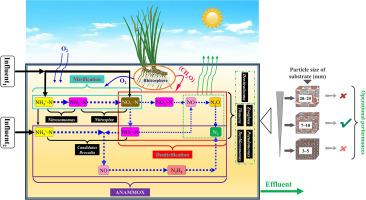Effect of substrate size on partial denitrification-ANAMMOX in a subsurface vertical flow constructed wetland with step-feeding
IF 4.1
2区 环境科学与生态学
Q1 ECOLOGY
引用次数: 0
Abstract
Subsurface vertical flow constructed wetlands (VFCWs) with step-feeding were used for the advanced treatment of anaerobically-digested swine wastewater taking rural domestic sewage as the external carbon source, the volume ratio between rural domestic sewage and anaerobically-digested swine wastewater after secondary treatment was defined as shunt ratio. This study explored the effect of substrate size (20–25, 7–10, and 3–5 mm) on partial denitrification-ANAMMOX (PD-A) in VFCWs at a shunt ratio of 1:3. Substrate size significantly affected the redox potential gradient and biofilm biomass content in the substrate layer, the diversity and abundance of the nitrogen-transforming microorganisms varied accordingly, leading to fluctuations in the intensity of nitrogen conversion processes (especially PD-A) in the VFCWs. When the substrate size was 7–10 mm, the abundance and activities of both ANAMMOX bacteria and denitrifying bacteria were significantly enhanced in the installation area of the shunt pipe, and there was an increase in the nitrifying-denitrifying performance in the upper substrate layer. Correspondingly, the total nitrogen, ammonia‑nitrogen, and nitrate‑nitrogen removal rates of the system reached (72.07 ± 2.61)%, (77.51 ± 1.98)%, and (64.46 ± 3.85)%, respectively. According to the contributions of functional gene groups associated with nitrogen transformations, it was concluded that appropriate substrate size enhanced PD-A and improved nitrogen removal through co-promotion of PD-A and simultaneous nitrification and denitrification in the VFCWs.

基质粒径对阶梯式垂直潜流人工湿地部分反硝化-厌氧氨氧化的影响
采用分段进料的地下垂直流人工湿地(VFCWs),以农村生活污水为外碳源,对厌氧消化猪废水进行深度处理,将二级处理后的农村生活污水与厌氧消化猪废水的体积比定义为分流比。本研究探讨了基质尺寸(20-25、7-10和3-5 mm)在分流比为1:3的VFCWs中对部分反硝化-厌氧氨氧化(PD-A)的影响。底物大小显著影响底物层氧化还原电位梯度和生物膜生物量,氮转化微生物的多样性和丰度也随之变化,导致VFCWs中氮转化过程(尤其是PD-A)强度的波动。当底物尺寸为7 ~ 10 mm时,分流管安装区厌氧氨氧化菌和反硝化菌的丰度和活性均显著增强,上层底物层的硝化反硝化性能有所提高。系统对总氮、氨氮和硝态氮的去除率分别达到(72.07±2.61)%、(77.51±1.98)%和(64.46±3.85)%。根据与氮转化相关的功能基因群的贡献,我们得出结论,适当的底物大小通过在VFCWs中共同促进PD-A和同时硝化和反硝化来增强PD-A和改善氮的去除。
本文章由计算机程序翻译,如有差异,请以英文原文为准。
求助全文
约1分钟内获得全文
求助全文
来源期刊

Ecological Engineering
环境科学-工程:环境
CiteScore
8.00
自引率
5.30%
发文量
293
审稿时长
57 days
期刊介绍:
Ecological engineering has been defined as the design of ecosystems for the mutual benefit of humans and nature. The journal is meant for ecologists who, because of their research interests or occupation, are involved in designing, monitoring, or restoring ecosystems, and can serve as a bridge between ecologists and engineers.
Specific topics covered in the journal include: habitat reconstruction; ecotechnology; synthetic ecology; bioengineering; restoration ecology; ecology conservation; ecosystem rehabilitation; stream and river restoration; reclamation ecology; non-renewable resource conservation. Descriptions of specific applications of ecological engineering are acceptable only when situated within context of adding novelty to current research and emphasizing ecosystem restoration. We do not accept purely descriptive reports on ecosystem structures (such as vegetation surveys), purely physical assessment of materials that can be used for ecological restoration, small-model studies carried out in the laboratory or greenhouse with artificial (waste)water or crop studies, or case studies on conventional wastewater treatment and eutrophication that do not offer an ecosystem restoration approach within the paper.
 求助内容:
求助内容: 应助结果提醒方式:
应助结果提醒方式:


